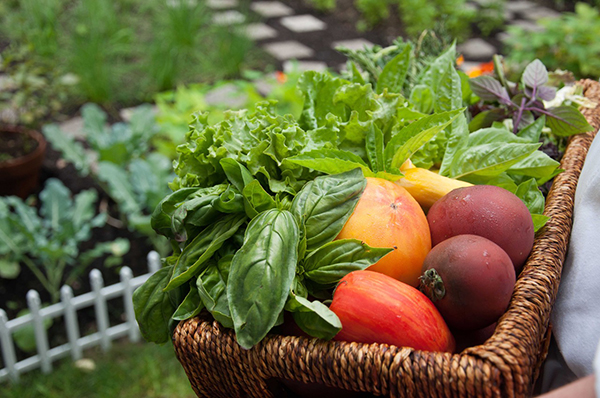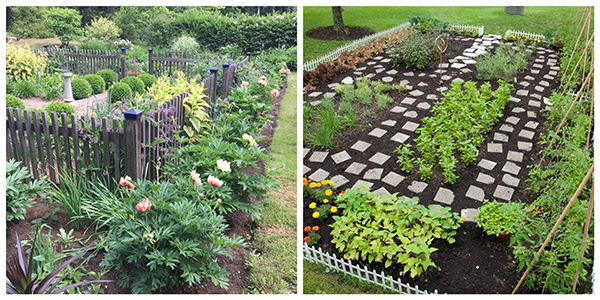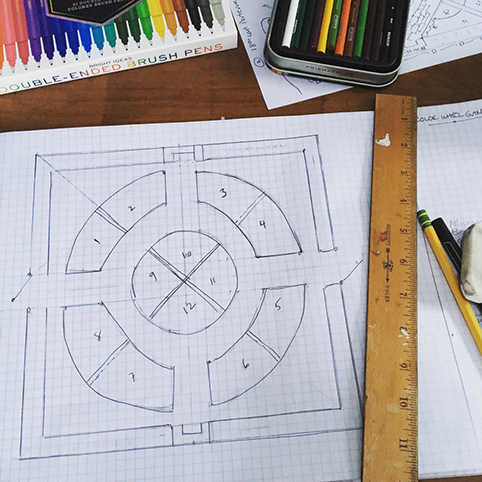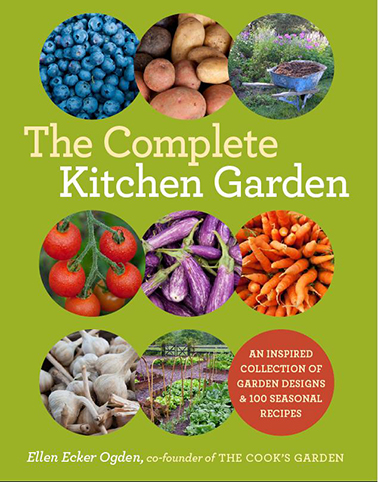
Kitchen garden and its bounty. Photo: Ali Kaukas, copyright The Complete Kitchen Garden Book by Ellen Ecker Ogden
Editor’s Note:
Spring is here and we are ready to get out to our gardens. In today’s climate, it’s more important (and fun!) than ever to consider putting in a kitchen garden. Picture yourself picking vegetables and herbs you’ve grown yourself. You’ll give yourself a pat on the back for all of the time you were able to skip going to the vegetable section of the supermarket.
At a loss where to begin? Of course, there are loads of videos and tips from garden centers, seed companies online.
Feeling overwhelmed?
If you need to be further inspired and wish you could have a garden consultant come over to help you, it’s possible to have a virtual garden designer.
Enter Ellen Ogden, is the author of six books on kitchen garden design including The Complete Kitchen Garden. She is a lecturer extraordinaire, speaking at botanical gardens and garden clubs nationwide.
Online design courses are offered on the EllenOgden.com website. Or you can contact her for a personal design. Her consultation service is helpful if you already have a garden but need or want to change it up. Newbie gardeners will appreciate the guidance on how to get started from scratch.
Over the next several weeks, we will be hearing from Ellen Ecker Ogden in a mini-series of articles. Here is part one.

Kitchen gardens. Photos (left) courtesy of Ellen Ogden; (right) Ali Kaukas copyright The Complete Kitchen Garden Book by Ellen Ecker Ogden
Grow Food Not Lawns
By Ellen Ogden
Why we garden is as individual as the plants themselves – for food, for beauty, to escape, or simply for exercise – the bottom line is that all gardeners start with the same three things; seeds, plants and soil, yet each of our gardens are completely unique.
We bring personality to the garden, just as we create homes that reflect our individual aesthetics. It’s pretty easy to plant a seed, watch it grow, and then savor the harvest. Yet designing a vegetable garden to be beautiful as well as practical takes learning a few techniques that save time, and help simplify the maintenance.
The truth is, good gardeners make it look easy – we all want that weed-free, always blooming, overflowing harvest basket type of garden. Yet in fact, gardening is messy. It takes getting dirty and devoting time to tasks that are not always rewarding. Gardening also requires ingenuity – figuring out solutions to challenges such as too much water, or not enough, pests and disease. Good gardeners also have indefatigable patience, and know that seeds take time, and waiting for blossoms to turn into flowers and fruit, is a reminder that the anticipation is part of the joy.
The word garden is derived from “garten” which means enclosure, which is apt when you consider that a garden is based on a cycle of life; seeds, growing, harvest and saving seeds to complete the circle for another round.
Gardeners naturally fall into the rhythm of the seasons, and intuitively know the way their own gardens respond to certain types of weather. A beautiful food garden can tap into all of the senses; you inhale more deeply, look more closely, taste with appreciation, listen with curiosity, and touch everything. When you design a garden to be both productive and beautiful, it heightens your awareness on every level.
Take a Bird’s Eye View
Too often, gardeners plunk a raised bed in the front or side yard, fill it with soil, and call it a garden. I compare this approach to eating fast food: it’s quick, it serves a purpose and it’s relatively effortless. Yet does this type of garden really satisfy? A well-designed garden starts with a plan on paper first, then is transferred to the landscape.

Start with a plan. Photo courtesy of Ellen Ogden
If this is your first garden, it may help to visualize your garden, like a bird looking down. Picture yourself in a favorite place in your backyard, for me, this is sitting on a bench under an old apple tree.
Close your eyes, and rise above the tree line, as if you had wings. Look down and see the way your land looks from above, the way your house sits, how your property connects to your neighbors, and perhaps the topography of the larger landscape beyond if there are mountains or nearby streams, or sidewalks and streets.
The best garden design integrates the whole landscape, taking into account the topography, the natural flow of the path from the driveway to the house, convenient sitting areas to relax, and of course the view.
 Vegetable gardens require full sun for most of the day, but try to minimize disturbance in your existing landscape, and collaborate with the natural contours, trees and wild areas that support the whole ecosystem. This benefits everybody and is a reminder that while deer and rabbits may be a nuisance, sometimes these disturbances are temporary, and won’t require a lot of high wire fencing.
Vegetable gardens require full sun for most of the day, but try to minimize disturbance in your existing landscape, and collaborate with the natural contours, trees and wild areas that support the whole ecosystem. This benefits everybody and is a reminder that while deer and rabbits may be a nuisance, sometimes these disturbances are temporary, and won’t require a lot of high wire fencing.
Start Small, Think Outside of the Box
Start small, and grow it incrementally. Once you have a design on paper, sometimes it helps to consult a professional landscaper to share your ideas and explore other options.
Think outside the box and look at a variety of designs before settling on one. Go beyond that raised bed, and create a beautiful kitchen garden that will give you long-lasting pleasure, and when that when you bring a freshly harvested salad to the table, you can proudly say, “I grew this!”











